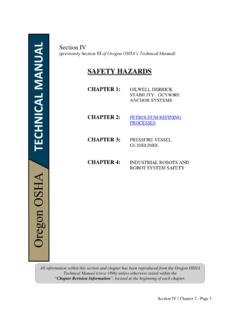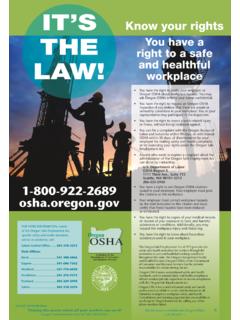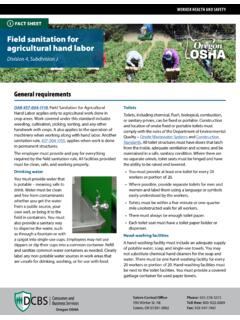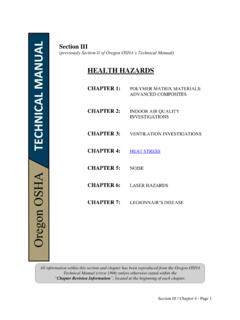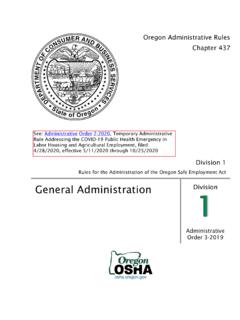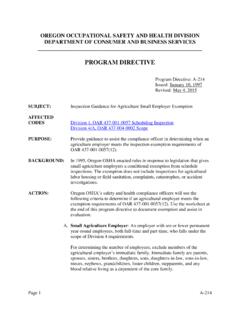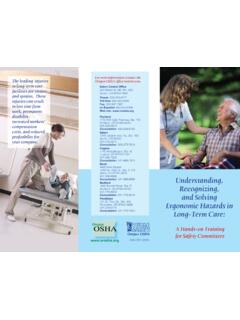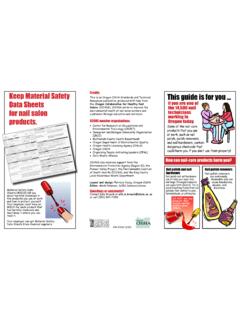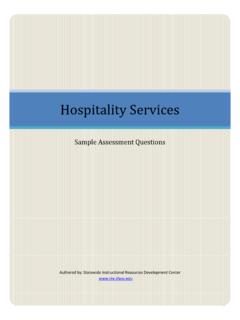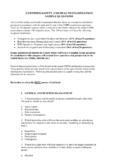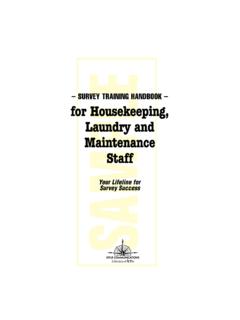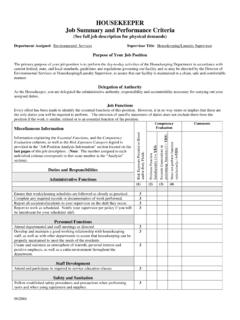Transcription of Bloodborne Pathogens - osha.oregon.gov
1 Bloodborne Pathogens :Questions and answers about Occupational ExposureOregon OSHAL ayout and cover design, Patricia Young, Oregon OSHA440-2261 (10-14) OR-OSHA1 TABLE OF CONTENTSI ntroduction .. 3 Section I Bloodborne Pathogens Standard .. 4 Section II Exposure Control Plans Exposure determination .. 8 Training .. 9 Section III Preventive Measures Hepatitis B vaccination .. 10 Universal precautions .. 11 Section IV Methods of Control Engineering controls and work practices .. 12 Personal protective equipment (PPE) .. 14 housekeeping .. 16 Labeling .. 18 Labeling requirements.
2 19 Section V Exposure Incidents .. 20 Section VI Recordkeeping .. 21 Appendix A Statement of Declination .. 23 Appendix B Bloodborne Pathogens Exposure Control Plan .. 24 Appendix C Example of Sharps Injury Log .. 30 Oregon OSHA Services .. 312In compliance with the Americans with Disabilities Act (ADA), this publication is available in alternative formats. Call the Oregon OSHA public relations manager, contained in this publication is in the public domain and may be reproduced without permission from Oregon intent of this question -and-answer manual is to help employers and employees understand the Oregon Occupational Safety and Health Division (Oregon OSHA) requirements regarding exposure to the hepatitis B virus (HBV), the human immu-nodeficiency virus (HIV), and other Bloodborne Pathogens , including the hepatitis C virus (HCV).
3 Acquired immunodeficiency syndrome (AIDS) and hepatitis B merit serious concern for workers occupationally exposed to blood, other potentially infectious materials, and certain other body fluids that contain such Bloodborne Pathogens as HIV and HBV. According to estimates of the Occupational Safety and Health Administration, more than million workers in health care and public safety occupations could be exposed to these workers include physicians, dentists, dental employees, phlebotomists, nurses, morticians, para-medics, medical examiners, laboratory and blood bank technologists and technicians, housekeeping personnel in health care institutions, laundry work-ers, employees in long-term care facilities, and home-care workers.
4 Other workers who may be occupationally exposed to blood or other potentially infectious materials, depending on their work assignments include research laboratory workers, first-aid responders, and public safety personnel (fire, police, rescue, correctional officers, etc.).Exposure to Bloodborne Pathogens occurs in many ways. Although needlestick injuries are the most common means of exposure for health care workers, Bloodborne Pathogens can also be transmitted through contact with eyes, nose, and mouth or through broken OSHA recognizes the need to safeguard workers from health hazards related to Bloodborne Pathogens . With the Bloodborne Pathogens standard, Oregon OSHA aims to reduce the risk of occupa-tional exposure to Bloodborne * Occupationally exposed means exposed during the performance of job duties to blood or other potentially infectious materials through skin, eyes, mucous membranes, or broken skin by needlesticks, human bites, cuts, abrasions, splashes, or other IBloodborne Pathogens StandardThe Bloodborne Pathogens standard tells how to determine who has occupational exposure and how to reduce workplace exposure to Bloodborne patho-gens.
5 Q What are Bloodborne Pathogens ? A Bloodborne Pathogens are microorgan-isms that can cause disease when transmit-ted from an infected individual to another individual through blood and certain body fluids. Bloodborne Pathogens are capable of causing serious illness and death. The most common illnesses caused by Bloodborne Pathogens are hepatitis B (HBV), hepatitis C (HCV), and acquired immunodeficiency syndrome (AIDS) from HIV, or human immunodeficiency virus. Q What is hepatitis B? A Hepatitis B is a liver disease caused by the hepatitis B virus (HBV). Hepatitis B, formerly called serum hepatitis, is a life-threatening Bloodborne pathogen and a major risk to employees in jobs where there is exposure to blood and other poten-tially infectious material (OPIM).
6 Hepatitis, which means inflammation of the liver, can be caused by drugs, toxins, autoimmune disease, and infectious agents, including What is hepatitis C? A Hepatitis C is a liver disease caused by the hepatitis C virus (HCV). It is the most common chronic Bloodborne infection in the United States and is primarily transmitted through large or repeated direct percutane-ous exposures to blood. Most people who are chronically infected are not aware of their infection because they are not clinically ill. Infected people can infect others and are at risk for chronic liver disease or other HCV-related chronic diseases. Currently there is no vaccine against hepatitis Who is covered by the Bloodborne Pathogens standard?
7 A Oregon OSHA s rule applies to all people occupationally exposed* to blood or other potentially infectious materials. Blood means human blood, blood products, or blood components. OPIM includes the following: H uman body fluids: semen, vaginal secre-tions, cerebrospinal fluid, synovial fluid, pleural fluid, pericardial fluid, peritoneal fluid, amniotic fluid, saliva in dental proce-dures, any body fluid visibly contaminated with blood, and all body fluids when it is difficult or impossible to differentiate between body fluids. Any unfixed tissue or organ (other than intact skin) from a human (living or dead). HIV-containing cell or tissue cultures, organ cultures, and HIV- or HBV-containing culture medium or other solutions as well as blood, organs, or other tissues from animals experimentally infected with HIV or Are there specific occupations covered by the standard?
8 A The hazard of exposure to infectious materials affects employees in many types of jobs. The following occupations are likely to be covered by the standard, but the scope of the standard is not limited to employees in these occupations: Physicians, physician assistants, nurses, nurse practitioners, and health care employ-ees in clinics and physicians offices Employees of clinical and diagnostic laboratories Housekeepers in health care facilities Workers in hospital laundries or commercial laundries that serve health care or public safety institutions Tissue bank personnel Employees of blood banks and plasma cen-ters who collect, transport, and test blood5* Collateral duty is not addressed in the standard, but is addressed in a Letter of Interpretation (Jan.)
9 15, 1997) and Program Directive (A-154), Bloodborne Pathogens . Employees of freestanding clinics such as hemodialysis clinics, urgent-care clinics, health maintenance clinics, and family- planning clinics Employees of clinics in industrial, education, and correctional facilities ( , those who collect blood and clean and dress wounds) Employees assigned to provide emergency first aid Dentists, dental hygienists, dental assistants, and dental laboratory technicians Employees of institutions for the develop-mentally disabled Hospice employees Home health care workers Employees of nursing homes and long-term care facilities Employees of funeral homes and mortuaries HIV and HBV research laboratory and production-facility workers Employees handling regulated waste Emergency medical technicians, paramedics, and other emergency medical service provid-ers Firefighters, law enforcement personnel.
10 And correctional officersQ How do employers determine if their employees are included in the scope of the standard? A The standard requires employers to evalu-ate each job task and procedure to determine which employees may be expected to be occupationally exposed to blood or other potentially infectious materials. The expo-sure determination is made without regard to the use of personal protective equipment (PPE), because employees are considered to be exposed even if they wear PPE. If it is deter-mined that sufficient evidence of reasonably anticipated exposure exists, the employer will be held responsible for providing the protections of OAR to the employees with occupational If I have employees who may rarely come into contact with blood or OPIM, do all of the rules still apply?

